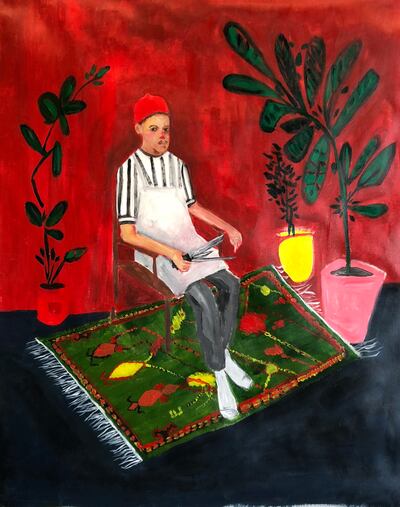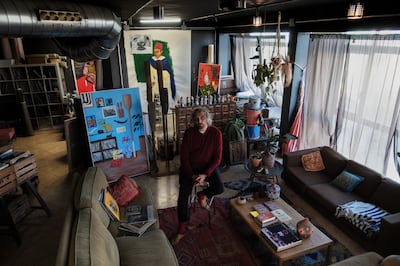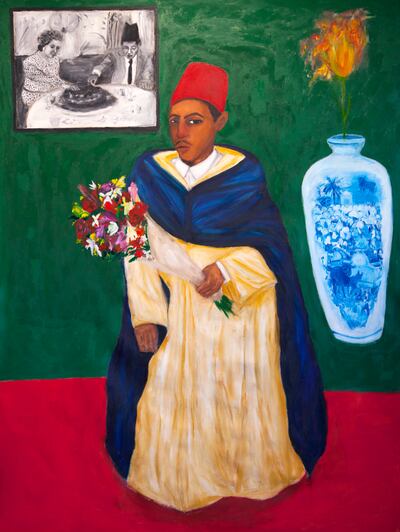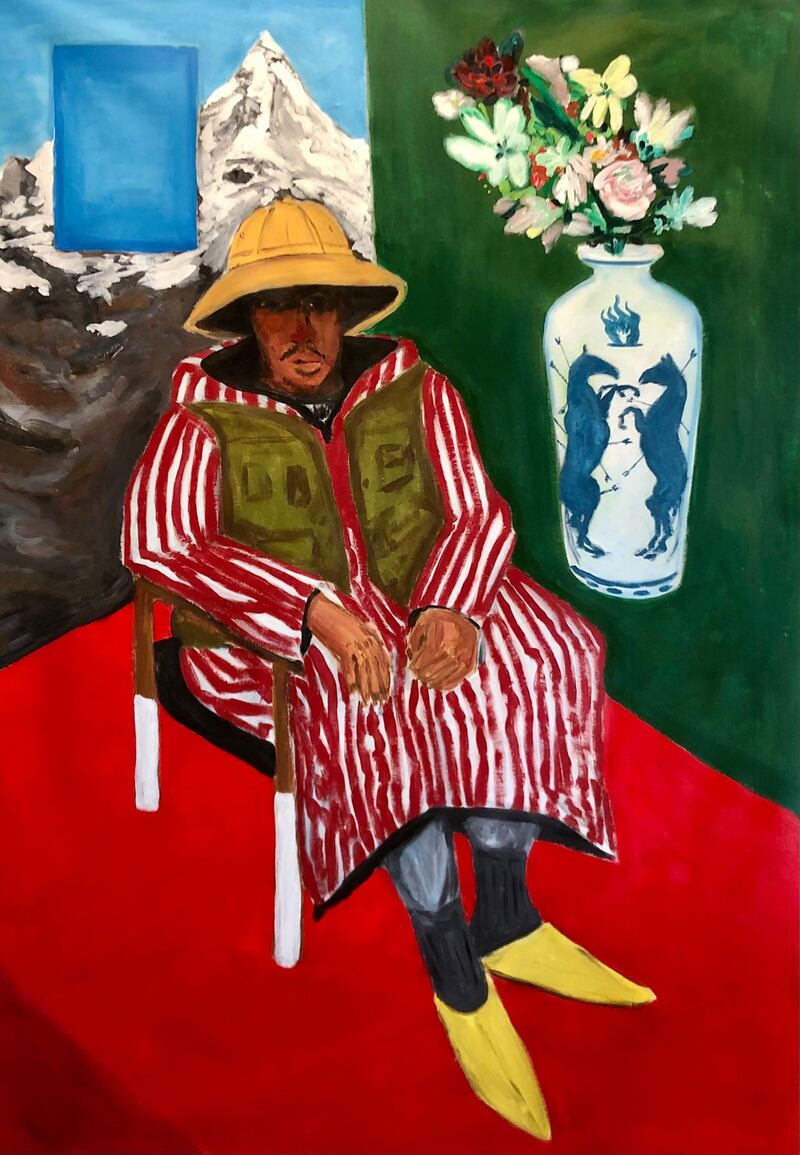Portraiture is not a hip genre. But Spanish-Moroccan artist Anuar Khalifi thinks there is life in it yet.
His paintings from the past few years revive the practice, replacing its typical European subjects with a young Moroccan man in a red fez or roomy jelaaba. He sits, knees spread casually apart, impression implacable, as if awaiting his subjects.
“The genre chose me,” says Khalifi. “Every time I visit museums, I feel attracted to portraits – but I don’t see figures that look like myself in those historical portraits. Before, some paintings of mine had a different energy, lots of movement. But now I keep it simple. If you want to ask big questions, you need a simple response.”
Khalifi’s works are on view online as part of Palimpsest, his show for The Third Line gallery, which is running until Friday, July 30. And his shift towards a fresher representation is elegantly done: gone are the stuffy, heavy colours and crowded picture planes of Northern European portrayals. In its place are the colours of the Moroccan landscape that he grew up visiting each year: sunny blues, lush greens and deep ochre reds.

But the artist preserves the classic composition of the portrait – and its essential weirdness: the sedentary pose in which sitters wait while the study is being made, and the accoutrements in the background that signal status, character traits or identity, all awkwardly placed around the subject.
In Baba the Butcher and Gardener (2019), a man in a fez and white apron sits on a chair on a patterned rug, a knife on his lap. The rug suggests a Middle Eastern context, as does the fez – but the title mocks any desire to make sense of it. Butcher? Gardener? Or maybe neither – paper-cutter?
In Safi Safari (2021), a man in pointed yellow slippers leans back, a snowy crested mountain behind him. He wears a flak jacket and wide-brimmed safari hat over his striped thobe, and a blue-and-white china vase in the corner shows two horses, their bodies pierced with arrows.
The variables at play are clear – colonialism, violence, identity – but how they stack up is not. Though Khalifi professes to have a simple solution to the question of representation, he is also at work confusing the viewer, using elements as visual distractions – such as a series in which he replaced his subjects’ noses with red triangles – or adding hermetic Sufi symbols.
“Paintings reveal themselves years later,” he says. “Not everything has to have meaning. And when we don't know the meaning we get confused, like it’s a trick, or a menace. But in the end, I am just showing you things, the viewer has to decide what he sees.”
Khalifi grew up in a small town in the Costa Brava region of Spain, north of Barcelona. The stretch of Mediterranean coast's main claim to cultural fame is being the birthplace of Salvador Dali – now commemorated in a museum that is almost an artwork in itself.

Khalifi had no formal training as an artist, but was always sketching, even through his thirties, when he worked as a DJ.
Like many immigrants of the Arab diaspora, Khalifi says he feels neither fully Spanish nor fully Moroccan – a fuzziness around identity that it is tempting to see in his work’s fascination with inscrutability. But for him, shifts in identity are also part of a historical process. He researches images of the Muslim world from old books, archives and the internet, as well as from his family’s personal collection.
He then updates these forms to bring them new life. An old black-and-white photograph of Moroccan King Hassan II and Queen Elizabeth II dining together appears in Palimpsest (2021), the titular work from his latest show. The two royals are painted into a canvas that hangs over the shoulder of a man holding flowers; both his king and the imagined man wearing the jaunty fez.
The painting’s title likewise nods to this idea: it refers to the practice where something is written over existing text, so that a shadow of the original peeps through. Even the fez, while it might appear to be a clear symbol of his subjects’ Arab identity, masks a high degree of flux.
“The fez is probably the last piece of clothing that the Muslims were using, in romantic photos of the past,” he says. “The fez was last worn in the 1950s, and then in Morocco it became a nationalist choice. The fez was even banned, at a certain point, and in the western view it became something to mock, like it’s a funny hat.”

In Khalifi's portraits it is somewhere between a marker of identity and a shock of red, one of a number of conical elements in the paintings. The works have a placid equilibrium that is all the more surprising in comparison to his earlier material, where every painting, he says, "was an act of vengeance".
Now in his forties, he says he's relaxed, taking stock of a historical field that has excluded him.
“Every piece of art is connected with every other piece of art. It’s a conversation – so I put myself in the conversation. Like: I'm here. Especially figurative art from a person from my background, it’s very rare.”
But he also contests the idea that the figure in his works is strictly autobiographical. His paintings’ meaning, he says, emerges form the conversation among the objects he surrounds the subjects with, drawn both from the Muslim world and his own reservoir: the personal and yet sadly shared territory of conflict over belonging in the Mediterranean.
Palimpsest is in The Third Line’s Online Viewing Room until Friday, July 30






